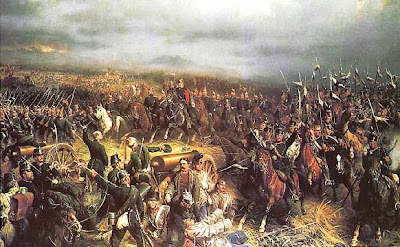Some musings on a historical period that fascinates me, the latter half of the 19th Century, "the day before yesterday" in historical terms
In the popular mind in Britain the Victorian era, indeed the entire period from Waterloo in 1815 to the opening of the Great War in 1914, is often seen as something of a golden age of peace. So too it was for Britain, interrupted only by small wars in distant places, and two medium ones in the Crimea and South Africa. From a British perspective this perception was largely correct, mainly because whatever fighting was involved was done by the top and bottom layers of society – the sons of the landed gentry and aristocracy on the one hand, and those of the underclass on the other. There was little impact on the middle classes and on what was recognised as “the respectable working class”.
Retaking of Suzhou city from the Taiping Rebels by Imperial Manchu troops
If a global perspective is however adopted the picture
changes significantly and the 1860s in particular may well have represented the
bloodiest single decade in human history up to that time. Conflicts that raged
at this time either during the decade or overlapping it, included:
- The Tai-Ping Rebellion in Southern China, 1850 to 1864, in which upwards of 20 million people are estimated to have died.
- The American Civil War 1861-65, which killed more Americans (roughly 625,000) than all that nation’s other wars combined and which saw the largest armies seen up to that time operating on a vast geographic scale.
- The “Tripartite War” of 1864-1870 in which Paraguay fought the three allied nations of Brazil, Argentina and Uruguay and in the process lost 390,000 of its combatants and approximately 1.2 million of its entire population, civilian and military. This equated to approximately 90% of the pre-war population and the conflict is regarded in relative terms as the most bloody in recorded history.
- Prussia’s wars against Denmark in 1864 and Austria in 1866 were relatively bloodless, though the victory at Königgrätz in 1866 cost the Prussians 2000 casualties and the Austro-Hungarians 31,000. These two “medium wars” were the prelude to the murderous Franco-Prussian War which would break out in 1870.
- As the decade opened the Second Italian War of Independence was still in progress, winding up a vicious campaign that had seen the French, Piedmontese and Austrians slaughtering each other at the Battles of Magenta and Solferino in 1859, the casualties at the latter being so terrible as to inspire Henri Dunant to establish the Red Cross.
- The French intervention in Mexico lasted from 1862 to 1866 and escalated what would have been a sufficiently nasty civil war into something greater in scope through France’s efforts to establish the Hapsburg “Emperor” Maximilian as its puppet ruler.
- Almost continuous Russian campaigns in Central Asia resulted in the conquest of Turkmenistan in the late 1860s, with further expansion in the decade that followed.
- The Polish Rising against Russian rule was mercilessly put down between 1863 and 1865.
- Civil Wars in Japan from 1864 onwards were a vital element in modernisers confronting traditionalists as the nation faced the challenge of opening up to the world outside.
- In 1868 the vicious “Ten Years War” commenced in Cuba as insurgents sought independence from Spain. This conflict was indeed the precursor to three decades of almost continuous guerrilla campaigns that culminated in the Spanish-American War of 1898.
- In Spain itself the revolution that toppled Queen Isabella II in 1868 was the precursor to several years of civil war, including the Third Carlist War that would rage from 1872-76.
The list
above takes no account of lesser colonial conflicts, or now-forgotten wars which
included the Colombian Civil War of 1860-62, the Colombian-Ecuadoran War of
1863, revolt against Ottoman rule in Crete and the Dominican Republic’s
liberation from Spain between 1863 and 1865.
Forgotten many
of these conflicts may now be, but each represented loss, tragedy and misery
for all those they touched.
Tripartite War: Brazilian forces (in blue) engage the Paraguayan army (in red or shirtless)
Russian troops advancing into the breach of a Central Asian fortress
Farewell to Europe: defeated Poles being transported to Siberia in 1863
(The artist, Aleksander Sochaczewski is himself the figure to the right of the column)
Prussian Victory at Königgrätz in 1866





No comments:
Post a Comment